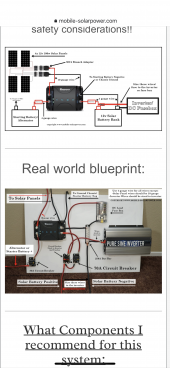hi. i’m new to all this, so please bear with me.
i got a promaster 2500 and need to install house batteries. i don’t stay in one place, i’m always moving and therefore don’t want to install solar panels to feed batteries etc. my plan is this, please let me know if this makes sense:
the mpp all in one 12v 1000w inverter unit. comes with ac input and output, and solar input.
sok 206ah battery (i may get 2)
12v dc fuse box and all the necessary bus bars, switches and in line fuses.
the mpp unit has ac input to charge batteries and solar input. but no input from van starter/battery. so my question is this:
can i use a dc to dc charger and write it from van battery to the solar input? if so do i need to be able to get a chargers that has adjustable amp output?
if i can’t do this can i just direct connect the dc to dc charger straight to the batteries? would doing this cause issues with the mpp all in one unit?
or should i just go with a 20a dc to dc charger to the batteries, a separate inverter, and not use the mpp all in one unit?
i’m just going to be running:
12v dc: led lights, mini fridge at times, usb charging bank
120v ac: small power tools and maybe at times charging 100.8v 1800wh electric unicycle at 5amps.
thank you
i got a promaster 2500 and need to install house batteries. i don’t stay in one place, i’m always moving and therefore don’t want to install solar panels to feed batteries etc. my plan is this, please let me know if this makes sense:
the mpp all in one 12v 1000w inverter unit. comes with ac input and output, and solar input.
sok 206ah battery (i may get 2)
12v dc fuse box and all the necessary bus bars, switches and in line fuses.
the mpp unit has ac input to charge batteries and solar input. but no input from van starter/battery. so my question is this:
can i use a dc to dc charger and write it from van battery to the solar input? if so do i need to be able to get a chargers that has adjustable amp output?
if i can’t do this can i just direct connect the dc to dc charger straight to the batteries? would doing this cause issues with the mpp all in one unit?
or should i just go with a 20a dc to dc charger to the batteries, a separate inverter, and not use the mpp all in one unit?
i’m just going to be running:
12v dc: led lights, mini fridge at times, usb charging bank
120v ac: small power tools and maybe at times charging 100.8v 1800wh electric unicycle at 5amps.
thank you




